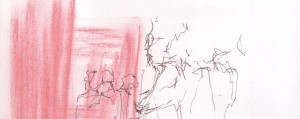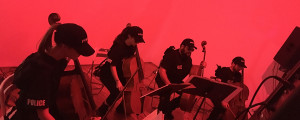‘Online social groups, that’s what clubbing is now.’ says Michail Stangl as he explains the changing nature of the way some interact with music during a discussion of Posthumanism at Unsound 2012. It’s a notion which the festival -in its tenth edition since starting as a still very underground affair in Poland’s cultural heart of Krakow -interrogates through a seemingly fatalistic theme of ‘The End’. Of course, while flash-in-the-pan online microgenres like hauntology and #seapunk might make you think much radical music is in the domain of the digital, it’s in seeing the epic and endless build-ups of YouTube phenomenon Evian Christ’s set, or the exquisite post-millennial DJing of Kuwaitee-American artist and producer, Fatima Al Qadiri, that you realise that just because something is of the virtual world, doesn’t mean it should to stay there.
While ‘digitisation as death to music’ is a question specifically brought up during the H+ talk on Posthumanism at the city’s Bunkier Sztuki, it’s an idea echoed and repeatedly refuted throughout the eight-day Unsound event. Whether it’s the submerged techno insurrection of Vessel or the rattling psychoacoustics of Brooklyn sound artist Ben Vida, there’s no denying the pure physicality of music in a real-time arena. There’s a smashed lamp by pure rhythmic force at Black Rain’s performance in Soviet modernist remnant, Hotel Forum, and brain-dissolving onslaught of Empty Set at the Manggha Museum. That’s not to mention the transcendental collaboration of Tim Hecker and Daniel Lopatin (Oneohtrix Point Never) St. Catherine’s Church. They had the grand Gothic structure quaking to the point of feeling like it really was the end of the world –or at least of the centuries old building that contained it.
Amongst the less affirmative of ideas of endings are the apocalyptic murmurings of the Unsound-commissions by Biosphere’s examination of the first New Mexico atomic weaponry tests in Kijów Cinema, as well as Demdike Stare and the Krakovia Sinfonietta’s abstract excursion into shifting world orders with the revelatory animation from director Michael England in the Tempel Synagogue. But even in those, there’s a powerful sense of expectation and rebuilding; a logical progression from last year’s desperate and helpless overload of the scifi-themed Futureshock. That’s not least because, as Unsound’s rising global reputation reaches a state of transition –contemplating its potential for lateral growth with rising audience numbers and increased funding –people like Jamie Teasdale (Kuedo) and the Quietus’ new music editor Rory Gibb explore ideas of man-made, boundary-pushing technologies in conversation, while artists like LA-based production duo Nguzunguzu and Russia’s drum n bass inspired producer Slava tug, pull and drop their distorted bass performances within the physical realms of live music.

Fatima Al Qadiri and vogue beats-inspired artists Mike Q have the most to offer in this post-internet era, where they inhabit a space that is a step up from the hyper-critical neo-psychedelia of last year’s Not Not Fun artists, for example, but still within a proto state of realistion. That’s where they’re still beholden to distinctions, between pop and the avant-garde, east and west, samples and real-time mixing; all of which you can recognise in a live setting. In fact, it’s the deviant PAN artist Heatsick and Californian sonic intellectual Holly Herndon that offer a more integrated experiences of broken-down boundaries and realising the conceptual sonically, while teetering across the intellectual and the emotional most fluidly. Yet, they too have shortcomings in presenting a homogenous Libertarian world-view, in contrast to the anti-didactic globalism as Al Qadiri’s sophisticated intercultural mixes through Islamic chants and modern pop or Theo Parrish’s genre mashes across time form his early Detroit Techno days, to Nirvana and contemporary RnB in a single early-morning set.
But in making up for the conceptual shortcomings every individual artist is bound to have, it’s the Unsound programme as a whole that utilises their strengths and perpetuates an intertextual conversation, criss-crossing across space and time and mirroring the plural, globalised, post-internet world that drives it. Presenting music, art and ideas in conversation with each other, Unsound 2012 offers a multiplicity of perspectives for a fly’s eye view of the world, all with an ear for asking the question, ‘where to from here?’
Poland’s Unsound Festival runs annually in October.




















